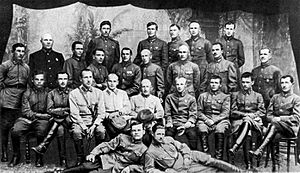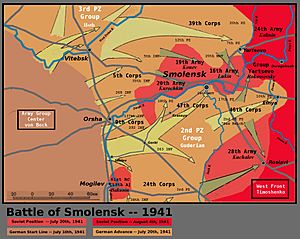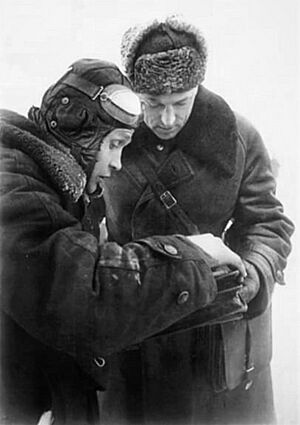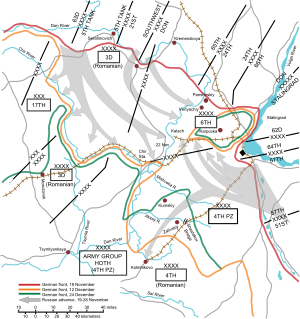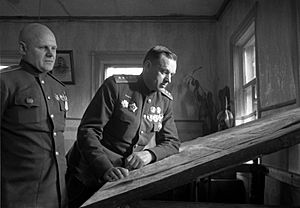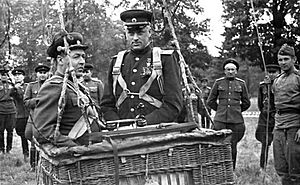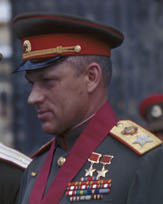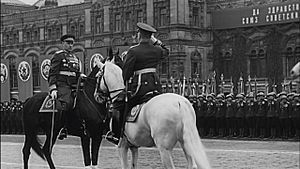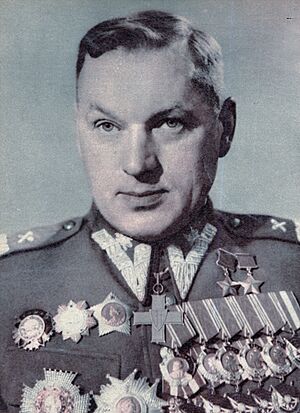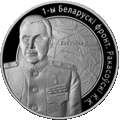Konstantin Rokossovsky facts for kids
Quick facts for kids
Konstantin Rokossovsky
|
|
|---|---|
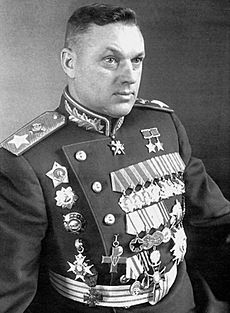
Konstantin Rokossovsky 1945
|
|
| Birth name | Konstanty Rokossowski |
| Born | 21 December 1896 Warsaw, Congress Poland, Russian Empire |
| Died | 3 August 1968 (aged 71) Moscow, Russian SFSR, Soviet Union |
| Buried | |
| Years of service | 1914–1937, 1940–1962 |
| Rank | Marshal of the Soviet Union Marshal of Poland |
| Signature | |
Konstantin Konstantinovich Rokossovsky (born December 21, 1896 – died August 3, 1968) was a top military leader from the Soviet Union and Poland. He became a Marshal of the Soviet Union and a Marshal of Poland. From 1949 to 1956, he served as Poland's Defence Minister.
Rokossovsky was one of the most important commanders of the Red Army during World War II. He is especially famous for planning and leading Operation Bagration. This was one of the most successful Red Army attacks of the war. He played a big part in almost every major operation that led to the Soviet victory over Germany.
Contents
Konstantin Rokossovsky: A War Hero
Konstantin Rokossovsky was born in Warsaw, which was then part of the Russian Empire. His family moved there because his father worked for the railway. His family had a history of cavalry officers. Konstantin's father was a railway official, and his mother was a teacher. When he was 14, Rokossovsky became an orphan. He worked in a stocking factory to support himself. In 1911, he started training as a stonemason.
Early Military Career
Rokossovsky joined the Kargopolsky 5th Dragoon Regiment in 1914. He quickly showed he was a skilled soldier and leader. He served in the cavalry throughout World War I. He was wounded twice and received the Cross of St George. In 1917, he joined the Red Army.
During the Russian Civil War, he led a cavalry squadron. He fought against the White Army in the Ural Mountains. In November 1919, he was wounded in the shoulder. He received the Order of the Red Banner, a high military award.
In 1921, he commanded the 35th Independent Cavalry Regiment. He helped bring Damdin Sükhbaatar to power in Mongolia. Rokossovsky's forces defeated a general named Roman von Ungern-Sternberg. He was wounded again, this time in the leg.
In Mongolia, he met Julia Barminan, a high school teacher. They married in 1923, and their daughter Ariadna was born in 1925. In 1924 and 1925, he attended the Leningrad Higher Cavalry School. There, he met Georgy Zhukov for the first time. He later returned to Mongolia to train the Mongolian People's Army.
Rokossovsky also took part in the Russo-Chinese Eastern Railroad War in 1929–1930. He served under Vasily Blyukher. In the early 1930s, his career became linked with Semyon Timoshenko and Georgy Zhukov. Rokossovsky was a division commander, with Zhukov as a brigade commander under him. Timoshenko was his superior.
Rokossovsky was one of the first to see the power of armored attacks. He strongly supported creating a powerful armored force for the Red Army.
Difficult Times and Return to Service
In August 1937, Rokossovsky faced serious accusations during Joseph Stalin's Great Purge. He was accused of being a spy. Many officers were arrested during this time. His Polish background and past associations may have led to his arrest.
Rokossovsky was accused of links to Polish and Japanese intelligence. He was also accused of sabotage. He was imprisoned in Kresty Prison in Leningrad. His wife and daughter were sent away from their home.
Rokossovsky refused to sign a false confession. He proved that one of his accusers had died years earlier. He survived mock execution ceremonies. He never spoke about his imprisonment with his family. He only told his daughter that he always kept a gun. He would not surrender alive if they tried to arrest him again.
He was released without explanation on March 22, 1940. His release happened as the purges eased. Semyon Timoshenko, the new Defence Minister, needed experienced officers. He returned Rokossovsky to command the 5th Cavalry Corps. Rokossovsky was promoted to major general. He then commanded the 9th Mechanized Corps.
World War II: A Key Commander
The German army is a machine, and machines can be broken!
1941: Facing the German Invasion
When Nazi Germany attacked the Soviet Union in June 1941, Rokossovsky commanded the 9th Mechanized Corps. He immediately faced large tank battles. These took place around the Lutsk–Dubno–Brody area. This was an early Soviet counter-attack.
Battle of Dubno
Rokossovsky's forces were ordered to attack. However, they faced many problems. These included issues with supplies and communication. His troops were behind schedule. His orders were to move to Lutsk and attack southwest.
On June 25, his 131st Motorized Division was pushed out of Lutsk. But his tank divisions managed to cut the Lutsk–Dubno road. German forces soon recaptured Dubno. Rokossovsky's command received conflicting orders. He decided to stop the counter-attack. He chose to defend against the enemy.
His decision meant that other Soviet forces attacking from the south did not get support. Communication problems were common. Rokossovsky's forces put pressure on the Germans at Lutsk. They also tried to recapture Rovno. His troops used 85mm anti-tank guns effectively. These battles helped slow the German advance. By July 7, Rokossovsky's corps had only 64 tanks left from 316.
Battle of Smolensk
In July 1941, the German Army Group Center attacked Byelorussia. Soviet forces there suffered huge losses. The Germans reached the Dnepr River, opening the way to Smolensk. Marshal Timoshenko was trying to rebuild the Soviet defenses there.
The Battle of Smolensk began on July 10. German forces attacked on a wide front. On July 13, Rokossovsky was ordered to Moscow. He was given command of the remnants of the 4th Army. He was promoted to lieutenant general.
On July 15, German forces reached Yartsevo, behind Smolensk. The next day, they forced Soviet defenders out of Smolensk. Three Soviet armies were in danger of being surrounded. Timoshenko then gave Rokossovsky a new task. He was to form "Group Yartsevo" to defend the area. This group had to stop the German forces from meeting up.
At first, Rokossovsky had only a small staff and a few vehicles. But over time, his group grew stronger. He gathered retreating soldiers and new reserve units. He had the 107th Tank Division and 101st Tank Division. The 101st had 220 older but working tanks.
A confusing battle for Smolensk followed. Parts of the city changed hands several times. Rokossovsky's group kept a path open and attacked German forces. His forces grew stronger each day. He used soldiers who escaped the Smolensk pocket.
The Germans had to deal with both the surrounded armies and Rokossovsky's growing forces. This slowed their advance. Rokossovsky's group managed to stop the German 3rd Panzer Group at Yartsevo. However, the German 2nd Panzer Group continued to advance south. On July 20, the 10th Panzer Division captured Yelnya.
On July 19, Hitler changed his orders. He wanted the German army to focus on Ukraine. This meant the deep push towards Moscow was paused. Rokossovsky's forces repelled a German attack towards Dorogobuzh.
On July 20, Zhukov ordered a counterattack. Attacks began along the entire front. Rokossovsky's forces temporarily drove the Germans from Yartsevo on the 24th. The Germans were taking many casualties. They needed to bring up infantry to support their tanks.
By July 25, the Germans were able to push north. On July 27, they captured bridgeheads over the Dnepr. This sealed the pocket around the Soviet armies. Rokossovsky tried to reopen the path. He could not regain control of the river crossings. But his 101st Tank Division recaptured Yartsevo on the 29th.
Rokossovsky is praised for slowing the German attack. He kept the Yartsevo corridor open long enough. This prevented many Soviet troops from being captured. His actions helped delay the German advance on Moscow.
Battle of Moscow
In September 1941, Stalin personally gave Rokossovsky command of the 16th Army. His new task was to defend the approaches to Moscow. He was now under the direct command of General Georgy Zhukov.
The 16th Army played a vital role in the Battle of Moscow. It was positioned along the main German advance route. This area saw fierce fighting during the German winter offensive of 1941. It also saw the Soviet counter-attack in 1941–42.
On November 18, 1941, German forces were trying to surround Moscow. Rokossovsky's soldiers were under heavy pressure. He asked Zhukov if he could pull back the 16th Army. Zhukov refused. Rokossovsky then spoke directly to Marshal Boris Shaposhnikov, who was Chief of the General Staff. Shaposhnikov immediately ordered a withdrawal. Zhukov quickly canceled this order and told Rokossovsky to hold his position.
After this, Rokossovsky's army was pushed back. The Germans gained important positions north of Moscow. However, this was the furthest the Germans advanced towards Moscow. Rokossovsky's 16th Army bore the brunt of the German attack on the capital.
1942: Southern Front and Stalingrad
Retreat to the Don
In March 1942, Rokossovsky was badly wounded by shrapnel. After two months in a Moscow hospital, he briefly rejoined the 16th Army.
In 1942, the German army launched "Operation Fall Blau". They shifted their attack south into eastern Ukraine. Their goal was to reach the Don and Volga rivers. They also aimed for Rostov, Voronezh, Stalingrad, and the Caucasus. The Germans hoped to secure oil supplies. The Soviet army retreated in good order. They set up a defensive line along the Don River.
On July 13, 1942, Rokossovsky was given command of the Bryansk Front. This showed his growing importance. Stalin expected the main German attack to resume against Moscow here. Rokossovsky was a trusted officer.
As the German offensive moved south, the Bryansk sector became quiet. Stalin personally called Rokossovsky. He then recalled him to Moscow for a new operation. This plan involved a strong counter-attack from the Serafimovich area. This plan was later used as "Operation Uranus".
Operation Uranus
By autumn 1942, the German army was at the Don and Volga rivers, focused on Stalingrad. They had also pushed south towards oil centers. Stalin was determined that Stalingrad would not fall. The Red Army was ordered to hold the city at all costs. The Battle of Stalingrad became a brutal fight for the city.
On September 28, 1942, Rokossovsky was given command of the Don Front. This front included the 65th, 24th, and 66th Armies. These armies faced German forces at Stalingrad.
"Operation Uranus" began on November 17. The goal was to surround the German 6th Army at Stalingrad. General Nikolai Fyodorovich Vatutin's Southwestern Front quickly defeated the Romanian army to the north. General Yeryomenko's Stalingrad Front attacked south of Stalingrad. Rokossovsky's Don Front supported Vatutin's attack. His armies pinned down the German defenders.
In less than a week, Soviet forces closed the gap behind Stalingrad. They began to strengthen their hold around the city. The German 6th Army did not try to break out. A German attempt to relieve the surrounded army failed. Soon after, the Soviets launched "Operation Little Saturn", which further secured their position.
Stalingrad Victory
On December 28, Stalin gave Rokossovsky the task of finishing off the Stalingrad pocket. He had about 212,000 men, 6,500 guns, 2,500 tanks, and 300 aircraft. They faced about 200,000 defenders. These defenders were short on food, fuel, and ammunition.
On January 8, 1943, Rokossovsky offered terms of surrender. But the German commander, Paulus, did not respond. Fighting continued.
On January 10, the Don Front launched "Operation Ring". This operation aimed to reduce the Stalingrad pocket. It began with a huge artillery barrage. The defenders fought hard. The Don Front suffered 26,000 casualties in the first three days.
On January 15, Rokossovsky was promoted to colonel general. On January 16, the main airfield used to supply the German 6th Army fell. The offensive continued, driving the Germans back into the city.
On January 26, the Soviets split the surrounded Germans into two pockets. On January 31, the southern pocket collapsed, and Paulus surrendered. Within four days, the last German defenders surrendered to Rokossovsky's command. This ended the Battle of Stalingrad. It marked a turning point in the war.
The troops of the Don Front at 4 pm on February 2nd, 1943 completed the rout and destruction of the encircled group of enemy forces in Stalingrad. Twenty-two divisions have been destroyed or taken prisoner.
– Konstantin Rokossovsky
1943: Battle of Kursk
After Stalingrad, Russian forces advanced. This created a bulge in the German line around Kursk. This was called the Kursk Salient. Rokossovsky's command moved to the north of this bulge. It was renamed the Central Front.
In February 1943, Rokossovsky wrote in his diary: "I'm appointed commander of the Central Front. It means that Stalin has entrusted me to play the key part in the summer Kursk campaign."
Both the Red Army and the Wehrmacht prepared for a major battle at Kursk. The Germans planned to attack from two sides to cut off Soviet forces. The Russians knew about the attack. They prepared strong defenses with many anti-tank units.
In late June, a German bomb hit Rokossovsky's headquarters. He survived because he had moved his signals group. After that, the Central Front HQ moved into an underground bunker.
The German attack, called "Operation Citadel", was delayed several times. This allowed the Soviets to prepare even more. The battle began in early July.
The Battle of Kursk was one of the largest tank battles in World War II. Both sides suffered huge losses. As commander of the Central Front, Rokossovsky faced a strong attack. The Germans used new Tiger I tanks. Rokossovsky organized his defenses into three belts. After the first German assault, he ordered counter-attacks. But Soviet tanks struggled against the new German heavy tanks. He then returned to a defensive strategy. The Germans got stuck in heavily mined areas and anti-tank defenses. Rokossovsky was able to bring in more troops.
Needless to say the Russians exploited their victory to the full. There were to be no more periods of quiet on the Eastern Front. From now on, the enemy was in undisputed possession of the initiative.
The Central Front was later renamed the 1st Belorussian Front. Rokossovsky commanded it during the Soviet advance through Belarus and into Poland.
1944: Operation Bagration and Warsaw
During the planning of Operation Bagration in 1944, a famous event happened. Rokossovsky disagreed with Stalin. Stalin wanted one main breakthrough point in the German lines. Rokossovsky argued for two breakthrough points. Stalin told him to "go and think it over" three times. Each time, Rokossovsky returned with the same answer: "two breakthroughs, comrade Stalin, two breakthroughs." After the third time, Stalin was silent. He walked over to Rokossovsky and put a hand on his shoulder. Everyone waited nervously. Instead of punishing him, Stalin said, "Your confidence speaks for your sound judgment." He then ordered the attack to follow Rokossovsky's plan.
The battle was a great success. Rokossovsky's reputation grew even more. After defeating the German Army Group Centre in Belarus, Rokossovsky's armies reached the east bank of the Vistula River near Warsaw in mid-1944. For these victories, he was promoted to Marshal of the Soviet Union. Stalin once said: "I have no Suvorov, but Rokossovsky is my Bagration".
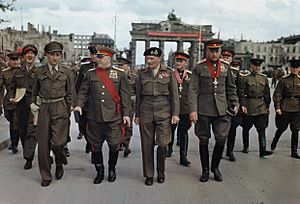
As Rokossovsky's forces neared the Vistula, the Warsaw Uprising (August–October 1944) began. This was led by the Polish Home Army. Rokossovsky did not send help to the Polish fighters. He always said that his supply lines were too stretched. Also, enemy pressure on his northern side was increasing. Sending forces to Warsaw would have been very risky.
In November 1944, Rokossovsky was moved to the 2nd Belorussian Front. This front advanced into East Prussia and then across northern Poland. They reached the mouth of the Oder at Szczecin. On May 3, 1945, he met with British Field Marshal Bernard Montgomery's 2nd Army in Wismar, Germany. Meanwhile, the forces of Zhukov and Ivan Konev captured Berlin, ending the war.
In July 1945, he, Zhukov, and other Soviet officers received the Order of the Bath in Berlin.
Post-War Life and Role in Poland
As a leading Soviet military commander, Rokossovsky was part of the Victory Parade in Red Square in Moscow in 1945. He was the Commanding Officer of the Parade. He rode a horse next to Marshal Georgy Zhukov.
After the war, Rokossovsky remained in command of Soviet forces in Poland. In October 1949, he became the Polish Minister of National Defense. He also received the title of Marshal of Poland. Rokossovsky was one of only two foreign Marshals to receive this rank.
Even though Rokossovsky was Polish, he had not lived in Poland for 35 years. Many Poles saw him as a Russian and Soviet representative. He once said: "In Russia, they say I'm a Pole, in Poland they call me Russian."
In 1952, he became deputy chairman of the Council of Ministers in Poland. He played a role in the Soviet influence over Poland and its army. He introduced methods to stop anti-Soviet activities. One example was the "labour battalions." Men considered "socially or politically insecure" were forced to work in dangerous conditions. Thousands were injured or died in these camps. Former Polish soldiers were also targeted.
In June 1956, protests against working conditions and Soviet influence happened in Poznań. Rokossovsky approved sending military units. Over 10,000 soldiers and 360 tanks were used. At least 74 civilians were killed.
After these events, Rokossovsky went to Moscow. He tried to convince Nikita Khrushchev to use force against Poland. However, a Polish leader named Władysław Gomułka negotiated with the Soviets. Rokossovsky was then forced to leave Poland.
He returned to the Soviet Union. His Soviet ranks and honors were restored. In July 1957, he became Deputy Minister of Defence. He also commanded the Transcaucasian Military District. In 1958, he became chief inspector of the Ministry of Defence. He held this post until he retired in April 1962.
Throughout his life, he enjoyed hunting.
Death
Konstantin Rokossovsky died in August 1968, at the age of 71. His ashes are buried in the Kremlin Wall Necropolis in Red Square.
Dates of Rank
- promoted major general, June 4, 1940
- promoted lieutenant general, July 14, 1941
- promoted colonel general, January 15, 1943
- promoted army general, April 28, 1943
- promoted Marshal of the Soviet Union, June 29, 1944
- declared Marshal of Poland, November 2, 1949
Family
Rokossovsky and his wife Julia had a daughter named Ariadna (1925–1978).
Honours and Awards
 Russian Empire:
Russian Empire:
 Cross of St. George, 4th class
Cross of St. George, 4th class Medal of St. George, 2nd, 3rd and 4th class
Medal of St. George, 2nd, 3rd and 4th class
 Soviet Union:
Soviet Union:

 "Gold Star" Hero of the Soviet Union, twice (July 29, 1944, June 1, 1945)
"Gold Star" Hero of the Soviet Union, twice (July 29, 1944, June 1, 1945) Order of Victory (No. 4 – March 30, 1945)
Order of Victory (No. 4 – March 30, 1945) Seven Orders of Lenin (August 16, 1936, January 2, 1942, July 29, 1944, February 21, 1945, December 26, 1946, December 20, 1956, December 20, 1966)
Seven Orders of Lenin (August 16, 1936, January 2, 1942, July 29, 1944, February 21, 1945, December 26, 1946, December 20, 1956, December 20, 1966) Order of the October Revolution (February 22, 1968)
Order of the October Revolution (February 22, 1968) Order of the Red Banner, six times (May 23, 1920, December 2, 1921, February 22, 1930, July 22, 1941, November 3, 1944, November 6, 1947)
Order of the Red Banner, six times (May 23, 1920, December 2, 1921, February 22, 1930, July 22, 1941, November 3, 1944, November 6, 1947) Order of Suvorov, 1st class (January 28, 1943)
Order of Suvorov, 1st class (January 28, 1943) Order of Kutuzov, 1st class (August 27, 1943)
Order of Kutuzov, 1st class (August 27, 1943) Medal "For the Defence of Stalingrad" (December 22, 1942)
Medal "For the Defence of Stalingrad" (December 22, 1942) Medal "For the Defence of Moscow" (May 1, 1944)
Medal "For the Defence of Moscow" (May 1, 1944) Medal "For the Defence of Kiev" (June 21, 1961)
Medal "For the Defence of Kiev" (June 21, 1961) Medal "For the Liberation of Warsaw" (June 9, 1945)
Medal "For the Liberation of Warsaw" (June 9, 1945) Medal "For the Capture of Königsberg" (June 9, 1945)
Medal "For the Capture of Königsberg" (June 9, 1945) Medal "For the Capture of Berlin" (June 9, 1945)
Medal "For the Capture of Berlin" (June 9, 1945) Medal "For the Victory over Germany in the Great Patriotic War 1941–1945" (May 9, 1945)
Medal "For the Victory over Germany in the Great Patriotic War 1941–1945" (May 9, 1945) Jubilee Medal "Twenty Years of Victory in the Great Patriotic War 1941-1945" (May 7, 1965)
Jubilee Medal "Twenty Years of Victory in the Great Patriotic War 1941-1945" (May 7, 1965) Jubilee Medal "XX Years of the Workers' and Peasants' Red Army" (February 22, 1938)
Jubilee Medal "XX Years of the Workers' and Peasants' Red Army" (February 22, 1938) Jubilee Medal "30 Years of the Soviet Army and Navy" (February 22, 1948)
Jubilee Medal "30 Years of the Soviet Army and Navy" (February 22, 1948) Jubilee Medal "40 Years of the Armed Forces of the USSR" (December 18, 1957)
Jubilee Medal "40 Years of the Armed Forces of the USSR" (December 18, 1957) Jubilee Medal "50 Years of the Armed Forces of the USSR" (December 26, 1967)
Jubilee Medal "50 Years of the Armed Forces of the USSR" (December 26, 1967) Medal "In Commemoration of the 800th Anniversary of Moscow"
Medal "In Commemoration of the 800th Anniversary of Moscow" Honorary weapon – sword inscribed with golden national emblem of the Soviet Union (1968)
Honorary weapon – sword inscribed with golden national emblem of the Soviet Union (1968)
 Polish People's Republic:
Polish People's Republic:
 China:
China:
 Denmark:
Denmark:
 France:
France:
 Grand Officer of the Legion d'Honneur (June 9, 1945)
Grand Officer of the Legion d'Honneur (June 9, 1945) Croix de guerre (1945)
Croix de guerre (1945)
 Mongolian People's Republic:
Mongolian People's Republic:
 United Kingdom:
United Kingdom:
 Honorary Knight-Commander of the Order of the Bath, (military division) (1945)
Honorary Knight-Commander of the Order of the Bath, (military division) (1945)
 United States:
United States:
Monuments and Memorials
-
Monument to Marshal of the Soviet Union Konstantin Rokossovsky in Ulan-Ude, Russia.
-
Monuments to Rokossovsky in Volgograd.
-
Aeroflot, Sukhoi Superjet 100, RA-89116 ('K. Rokossovsky').
-
Commemorative coin of Belarus, 2010.
-
Postage stamp of Soviet Union, 1976.
-
Postal cover of Russia, 1996.
-
Postage stamp of Kyrgyzstan, 2005.
See Also
 In Spanish: Konstantín Rokossovski para niños
In Spanish: Konstantín Rokossovski para niños


